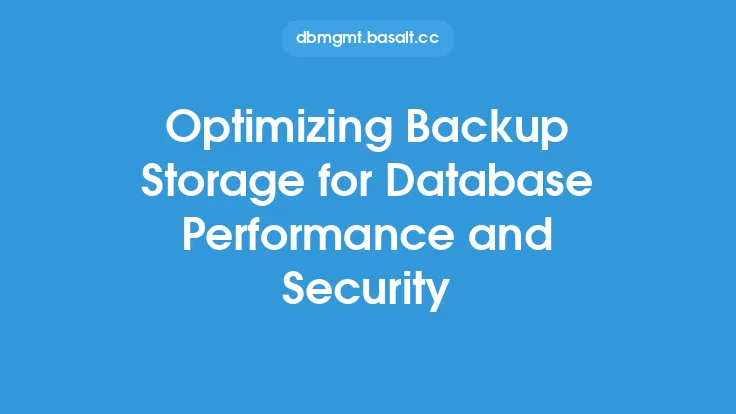When it comes to designing a database architecture for optimal performance, there are several key considerations that must be taken into account. A well-designed database architecture is crucial for ensuring that a database can handle a large volume of data and scale to meet the needs of a growing application or user base. In this article, we will explore the key components of a database architecture and provide guidance on how to design a database for optimal performance.
Introduction to Database Architecture
A database architecture refers to the overall structure and organization of a database, including the relationships between different components and the flow of data between them. A well-designed database architecture is essential for ensuring that a database can handle a large volume of data and scale to meet the needs of a growing application or user base. There are several key components of a database architecture, including the database management system, storage, networking, and security.
Database Management System
The database management system (DBMS) is the software that manages the database and provides a interface for interacting with the data. The DBMS is responsible for storing, retrieving, and manipulating data, as well as enforcing data integrity and security constraints. There are several different types of DBMS, including relational, NoSQL, and graph databases, each with its own strengths and weaknesses. When selecting a DBMS, it is essential to consider the specific needs of the application or use case, including the type and volume of data, the required level of scalability and performance, and the need for data consistency and durability.
Storage Considerations
Storage is a critical component of a database architecture, as it determines how data is stored and retrieved. There are several different types of storage, including hard disk drives (HDD), solid-state drives (SSD), and flash storage. Each type of storage has its own strengths and weaknesses, including differences in performance, capacity, and cost. When designing a database architecture, it is essential to consider the storage requirements of the application or use case, including the volume of data, the required level of performance, and the need for data durability and availability.
Networking and Connectivity
Networking and connectivity are also critical components of a database architecture, as they determine how data is transmitted between different components of the system. There are several different types of networking protocols, including TCP/IP, HTTP, and FTP, each with its own strengths and weaknesses. When designing a database architecture, it is essential to consider the networking requirements of the application or use case, including the volume of data, the required level of performance, and the need for data security and integrity.
Security Considerations
Security is a critical component of a database architecture, as it determines how data is protected from unauthorized access and other security threats. There are several different types of security measures, including authentication, authorization, and encryption, each with its own strengths and weaknesses. When designing a database architecture, it is essential to consider the security requirements of the application or use case, including the need for data confidentiality, integrity, and availability.
Data Modeling and Schema Design
Data modeling and schema design are also critical components of a database architecture, as they determine how data is organized and structured. A well-designed data model and schema are essential for ensuring that data is consistent, accurate, and scalable. There are several different types of data models, including entity-relationship models, object-oriented models, and dimensional models, each with its own strengths and weaknesses. When designing a database architecture, it is essential to consider the data modeling and schema design requirements of the application or use case, including the need for data consistency, accuracy, and scalability.
Indexing and Query Optimization
Indexing and query optimization are also critical components of a database architecture, as they determine how data is retrieved and manipulated. A well-designed indexing strategy and query optimization plan are essential for ensuring that data is retrieved and manipulated efficiently and effectively. There are several different types of indexing strategies, including B-tree indexing, hash indexing, and full-text indexing, each with its own strengths and weaknesses. When designing a database architecture, it is essential to consider the indexing and query optimization requirements of the application or use case, including the need for data retrieval and manipulation performance.
Scalability and Performance Considerations
Scalability and performance are critical components of a database architecture, as they determine how well the database can handle a large volume of data and scale to meet the needs of a growing application or user base. There are several different types of scalability and performance considerations, including vertical scaling, horizontal scaling, and distributed databases, each with its own strengths and weaknesses. When designing a database architecture, it is essential to consider the scalability and performance requirements of the application or use case, including the need for data handling and scalability.
Best Practices for Database Architecture
There are several best practices for designing a database architecture for optimal performance, including:
- Using a well-designed data model and schema
- Implementing a robust indexing strategy
- Optimizing queries for performance
- Using a scalable and performant DBMS
- Implementing a robust security plan
- Using a reliable and performant storage solution
- Implementing a robust networking and connectivity plan
By following these best practices, developers and database administrators can design a database architecture that is optimized for performance, scalability, and security.
Conclusion
In conclusion, designing a database architecture for optimal performance requires careful consideration of several key components, including the DBMS, storage, networking, security, data modeling, indexing, and query optimization. By following best practices and considering the specific needs of the application or use case, developers and database administrators can design a database architecture that is optimized for performance, scalability, and security. Whether you are designing a new database or optimizing an existing one, a well-designed database architecture is essential for ensuring that your database can handle a large volume of data and scale to meet the needs of a growing application or user base.





